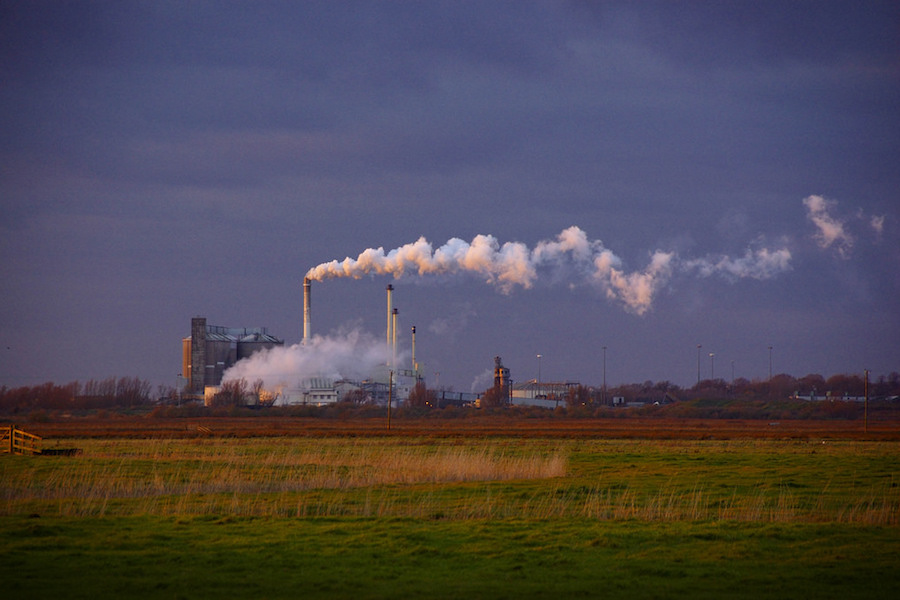The practical question in Washington today is not whether regulations will go, but whether anything will replace them
A ray of light may be piercing the cloud of gloom that settled over climate policy after the November election. It comes from an unexpected source: grand old men of the Republican Party and prominent conservative economists. In same-day op-ed pieces in the Wall Street Journal and New York Times, they unveiled a climate strategy that aims to win support on both sides of the aisle, uniting environmentalists, growth advocates, libertarians and populists around a common cause.
A conservative plan for climate action
Recalling President Ronald Reagan’s advocacy for the 1987 Montreal Protocol, the international treaty that protects the Earth’s delicate ozone layer, George Shultz and James Baker (who served in Reagan’s cabinet as Secretary of State and Secretary of the Treasury, respectively) call in the Wall Street Journal for “the Grand Old Party to once again lead the way” in rising to the greatest environmental challenge of our era.
In the New York Times, Harvard economists Martin Feldstein and Gregory Mankiw (who chaired the Council of Economic Advisers under presidents Reagan and George W. Bush, respectively) and Ted Halstead, founder of the Climate Leadership Council, write that rather than simply repealing climate regulations left by the Obama administration, Republicans should embrace a “repeal and replace” strategy that protects the climate in a way that’s “pro-growth, pro-competitiveness, and pro-working class.”
The centerpiece of their strategy is carbon dividends: recycling revenues from a carbon tax back to the American people as equal quarterly dividend checks. For a family of four, dividends from a $40/ton carbon tax would amount to about $2,000/year.
To protect the competitiveness of American producers, they call for border price adjustments: fees on the carbon content of imports from countries that do not have comparable carbon pricing, and rebates on carbon taxes paid by exporters to such countries.
Obama-era regulations made unnecessary by the carbon tax would be eliminated, including the Clean Power Plan, which the Trump administration already has vowed to repeal.
Echoing an argument long made by climate policy advocates, the proponents maintain that the strategy would promote robust economic growth by encouraging innovation and investment in new energy sources.
Reactions
Early reactions to the proposal have been mixed. Predictably, Breitbart News was having none of it. Ronald Reagan “is reaching for the celestial sickbag over this absurd proposal,” a commentator jeered within hours of the op-eds, urging the Trump administration to tell the Republican elder statesmen, “in the nicest possible way, exactly where they can shove their carbon tax.”
Former Republican presidential candidate Mitt Romney lauded it on Twitter as a “thought-provoking plan from highly respected conservatives to both strengthen the economy & confront climate risks.”
The Nature Conservancy immediately released a statement applauding the plan. The president of the Natural Resources Defense Council was less positive, telling the Washington Post that while a carbon price could be important in a comprehensive climate policy, it should not replace existing regulations.
Pricing v. regulation?
In principle, carbon pricing and regulation can co-exist. California’s cap-and-trade program, for example, complements state regulations rather than substituting for them. The cap-and-trade program for sulfur-dioxide emissions from power plants, created by the 1990 Clean Air Act amendments under President George H.W. Bush, likewise supplemented regulatory standards rather than replacing them.
Yet, many existing carbon regulations were introduced by the Obama administration as a fallback alternative in response to the failure by Congress to pass legislation that would have put a price on carbon.
There may be good reasons to maintain some existing regulations or even craft new ones. For example, fuel economy standards for automobiles that mandate a 54.5 miles/gallon average for the 2025 model year may inspire manufacturers to accelerate investments in innovations, including electrified vehicles, that yield high payoffs in years ahead.
Regulations can also be important in preventing “hot spots” where hazardous co-pollutants that are emitted along with carbon impose unacceptable risks on local populations. A one-size-fits-all carbon price does not take into account how public health benefits vary across pollution sources.
But it would require a considerable leap of faith to imagine that no regulations would be rendered superfluous by carbon pricing. For example, the Clean Power Plan’s carbon emission standards for power plants could become redundant once a serious carbon price is in place.
Moreover, all signs emanating from Washington are that the power plan will be scrapped by the new administration. If so, the practical question is not whether regulations will go, but whether anything will replace them.
Antecedents
The idea of carbon dividends originated more than a decade ago with the entrepreneur Peter Barnes, whose visionary book Who Owns the Sky? made the case for carbon dividends on the grounds that the atmosphere’s limited ability to absorb carbon emissions belongs to the people, and that everyone should share in payments for use of this scarce resource.
Over the years this idea gained modest political traction, notably in the cap-and-dividend bills proposed by Senators Maria Cantwell (D-Wa) and Susan Collins (R-Me) and by then Congressman (now Senator) Chris Van Hollen (D-Md).
However, bipartisan support for climate policy instead coalesced around cap-and-trade plans that would have awarded free carbon permits to polluters (rather than auctioning the permits as in cap-and-dividend). In this case, the revenue from the carbon price paid by consumers would have gone to corporations that got free permits, a windfall that proponents of the policy thought would neutralize opposition by the fossil fuel industry.
That hope proved unfounded. Successive cap-and-trade bills — McCain-Lieberman (2003), Lieberman-Warner (2007), and finally Waxman-Markey (2009) — all failed to survive the legislative gauntlet on Capitol Hill. Part of the opposition came from fossil fuel lobbyists whose preferred option turned out to be no policy at all, and from industry-funded climate change denialists.
But opposition also came from centrist Republican politicians who did not want to back a tax that would spark voter resentment. “By imposing a tax on every American who drives a car or flips on a light switch,” declared House Speaker John Boehner in opposing the Waxman-Markey bill, “this plan will drive up the prices for food, gasoline and electricity.” Democrats contested this argument, memorably claiming that the cost to the average American would be “about the price of a postage stamp per day.” But, in fact, Boehner was right. The postage stamp number came from a Congressional Budget Office study that estimated the cost of clean energy and efficiency investments to reduce emissions. Boehner was talking about the price that consumers would pay for emissions that are not reduced, much of which would have wound up as those windfall profits for energy companies.
Carbon dividends do not clear the political hurdle posed by the vested interests of corporations who do not want their fossil fuel reserves turned into stranded assets. But dividends do surmount the hurdle raised by Boehner, by turning the tax (a regressive one at that) into a net financial gain for the majority of Americans, benefiting low-income households and protecting real incomes of the middle class.
Carbon dividends could even dent opposition from those who doubt that climate change is real since, as its proponents note, the plan’s economic benefits “accrue regardless of one’s views on climate science.” Indeed James Baker says he’s still uncertain as to whether humans are responsible for climate change. But in the face of uncertainty, he and George Shultz write in their op-ed that “the responsible and conservative response should be to take out an insurance plan.” For most Americans, whose dividends would exceed what they pay in higher fuel prices, this insurance policy would not only be free, it would pay them.
Setting the carbon price
A key feature of any carbon pricing policy is whether the price is high enough to drive the necessary reductions in fossil fuel consumption within the necessary time frame. A price of $40/ton would be a good start, but it would need to rise over time. The question is how.
This is one reason why some carbon dividend backers (myself included) have favored a carbon cap over a carbon tax. Under a cap with auctioned permits, as in the Regional Greenhouse Gas Initiative of the northeastern states, the number of permits is fixed by the cap and their price can vary. Under a tax, the price is fixed and the quantity can vary. Apart from this, the two are equivalent. Because the precise relationship between price and quantity cannot be known in advance — no one can say exactly what price will reduce emissions by a specified amount, especially over the medium and long run — a cap that “gets quantities right” is the better way to hit the target.
Carbon tax proponents worry, however, that fluctuations in permit prices would impede long-range planning by investors. They also worry that cap-and-permit systems could be opened to permit trading and market speculation, or weakened by “offsets” that offer polluters alternatives to buying permits.
One way to address the concerns on both sides of this debate is to combine a cap and a tax in a hybrid policy. For example, changes over time in the tax could be calibrated to the quantity of emissions, rising automatically whenever reductions fall short of the targets. This strategy was implemented in Switzerland’s carbon levy on power plants.
The case for carbon dividends
In the past, support for carbon dividends has been limited by competing preferences of carbon pricing advocates. Among conservatives, the go-to option has been to use carbon revenue to cut other taxes, especially corporate income taxes, in the belief that this would spur economic growth. This belief is grounded in the orthodox doctrine that income taxes necessarily impose an “excess burden” on the economy, lowering total output by reducing supplies of labor and capital. This supply-side theory is taught as gospel in most graduate economics programs, despite the widespread phenomena of unemployed labor and idle capital – in other words, excess supply of both factors of production – in the real world.
Among liberals, the go-to option typically is to earmark the carbon revenue for worthy public purposes, especially clean energy investments. At first blush this may seem like a way to speed the transition from fossil fuels, but as long as the policy includes quantitative limits on emissions it could affect only how the emission targets are met, not total emissions. For example, if the money is used to subsidize more efficient electrical appliances, this frees more space for emissions from other sources like transportation fuels.
Liberals also often contend that any payments to shield consumers should be means-tested, with eligibility restricted to the needy. While this would mitigate the regressive impact of carbon pricing, it would raise administrative cost. Dwarfing this concern, however, may be the political cost of excluding the middle class. Much as the universality of Social Security and Medicare has safeguarded these programs from rollback attempts over the decades, universal dividends could safeguard climate policy over the decades needed to complete the clean energy transition.
For many conservatives and liberals, dividends may remain second to their favorite alternatives. But given that neither side has the political muscle to prevail on its own, dividends may define the scope for a political compromise that brings an effective carbon price. To their credit some prominent conservatives have figured this out. It remains to be seen whether they can enlist significant support from their fellow Republicans, and whether their liberal counterparts will figure it out, too.






